When you buy through links on our articles, Future and its syndication partners may earn a commission.

In the hush-hush, secretive world of space-based spy satellites, few details are publicly available — and groups like the U.S. Space Force, National Reconnaissance Office, the Central Intelligence Agency, and the National Geospatial-Intelligence Agency like it that way.
There’s an armada of classified spacecraft assigned an array of vigilant duties. Some intercept radio waves or detect missile launches. Others yield close-up looks at select areas using sharp-eyed optical systems or scan Earth with powerful radar technology.
These high-flying satellites are tempting targets for amateur astrophotographers. Such is the case for space watcher veteran Felix Schöfbänker in Upper Austria. “My images have certainly revealed a few things that either were not known, or only were speculated before,” Schöfbänker tells Space.com.
In the past few months Schöfbänker has caught some classified spy satellites with his 14″ Dobsonian telescope, optimized for satellite tracking and imaging from his home. Poring over imagery, he is sharing his results and what those images suggest.
Coming into focus for Schöfbänker, for example, has been a new generation of optical and radar imaging U.S. reconnaissance satellites, hurled into space for the National Reconnaissance Office (NRO), which designs, launches and operates spy satellites on behalf of the U.S. federal government.
Caught on camera
The (Future Imagery Architecture) FIA-Radars, also called Topaz, are five US spy satellites that carry a Synthetic Aperture Radar (SAR) for imaging. This technology can see through clouds and works night and day. They are the successors to the Lacrosse/Onyx series of SAR satellites.
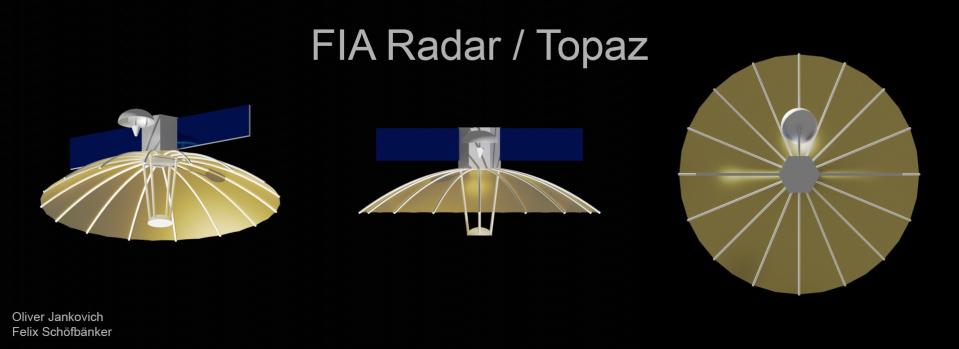

“From my images I conclude that these satellites have a parabolic mesh antenna which is roughly 12 meters [39 feet] in diameter, and 2 solar panels with roughly 10 meters [33 feet] of wingspan,” Schöfbänker points out.
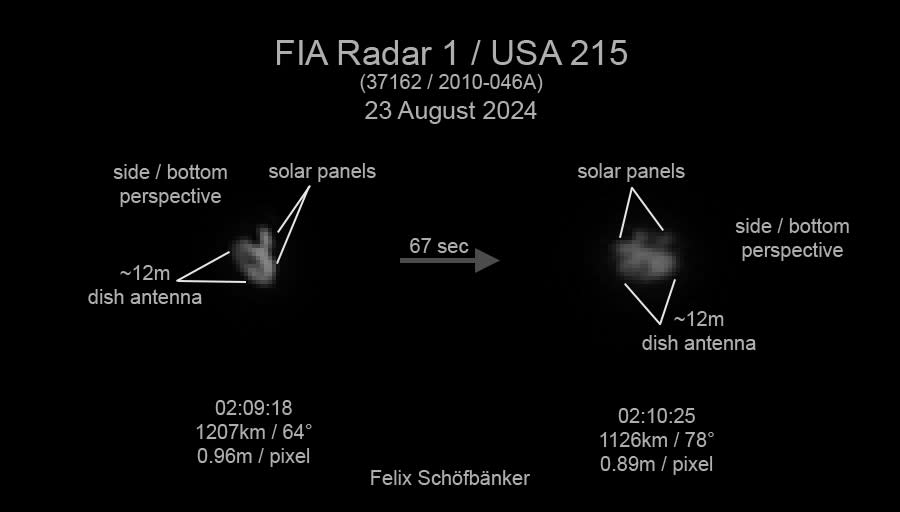

“There also is another bright object between the solar panels that I interpret as an up- and downlink antenna, though this also might be something else,” he added.
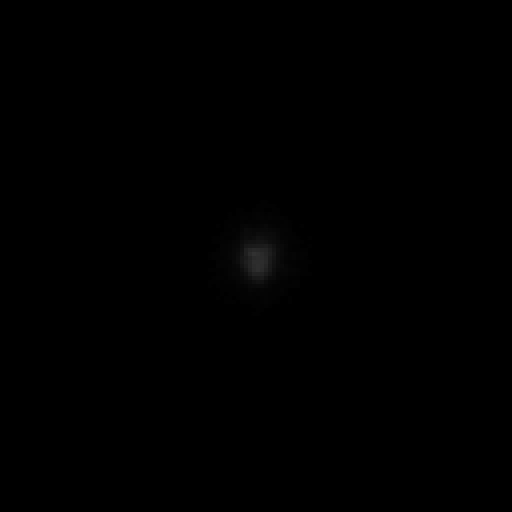

These SAR satellites create images by sending out lots of pulses and then applying computer processing to convert the returned signals into an image, said Schöfbänker.




“The antenna of the FIA radars can be pointed either left or right looking relative to the orbit. I have observed these satellites a total number of 28 times so far,” Schöfbänker said. “Only six times the antenna was looking to the left side and 22 times right looking,” he pointed out.


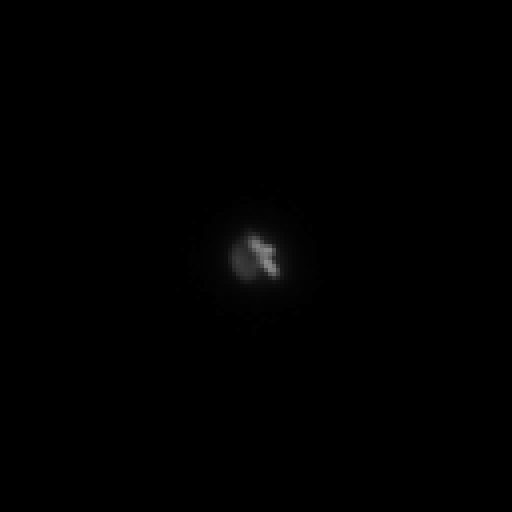

Electro-optical satellites
Schöfbänker has also cross-haired with his equipment the “KH-11 Kennen” electro-optical satellites that were first introduced in 1976. “They are somewhat similar to the Hubble Space Telescope, but optimized to look down to Earth, instead of studying space,” he said.
Currently, there are four of them in orbit, which are from three different generations of this type of secretive satellite.
“The oldest one currently up there was launched in 2005. It is a third generation KH-11 with the name USA 186. The next two are called USA 224 and USA 245, and these are the fourth generation from 2011 and 2013,” Schöfbänker said. “The newest one is a fifth generation spacecraft from 2021 and is called USA 314.”


Mirror matters
From his collection of KH-11 images, he has deduced that they are on the order of approximately 36 feet (11 meters) long.
“The mirror size seems to change for different generations,” Schöfbänker suggests. “The way I measured this was by looking at the diameter of the optical tube assembly. Usually the tube isn’t much larger than the mirror in it,” he advised.
So by measuring these sizes Schöfbänker was able to figure out that the oldest current KH-11 (USA 186, generation three), has a rough mirror size of 2.4 meters, some 8 feet. It is known that earlier generations used this size mirror, he said.
For the fourth generation (USA 224, USA 245), the satellite watcher measured a mirror diameter somewhere around 3 meters, roughly 10 feet across. “I am not sure what mirror size is used in USA 314 because I haven’t gotten many good images of it so far,” said Schöfbänker.
Different kind of design
Another spacecraft that has caught Schöfbänker’s attention is an unknown type.
“In July, I managed to get a look at a satellite called ‘USA 290’ which is suspected of possibly being another KH-11. But my image shows a different kind of design, which doesn’t look like a typical KH-11. My image shows a large, roughly 5 meter long rectangular panel. Another fact that supports my idea is the strange orbit this satellite is in. KH-11s are launched into Sun Synchronous orbits. USA 290 wasn’t,” observes Schöfbänker.
Sun synchronous orbits make sense for an optical imaging mission like the KH-11, since they pass over an area at the same time every day.
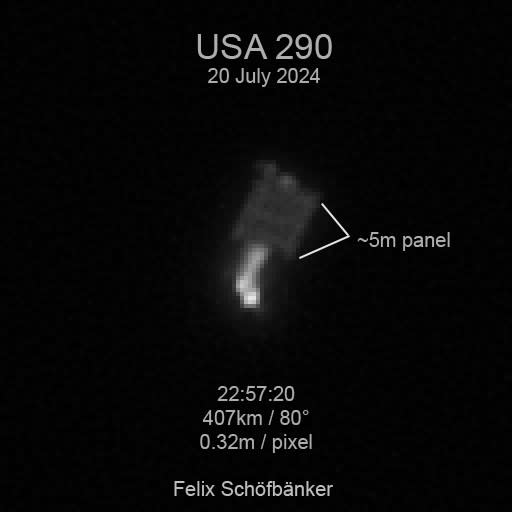

A few possibilities
Schöfbänker said there are a few possibilities as to what this panel could be.
A radiator which would work as a cooling system for a possible infrared imaging system is one idea. Or perhaps it’s a phased array antenna that could be used for SAR imaging or signal intelligence.
Maybe it’s a solar panel, Schöfbänker continued, “although I think it’s less likely due to the fact that the panel seems to be fixed on the rest of the structure. So tracking the sun would require moving the entire satellite.”
Safe to say
RELATED STORIES:
— China’s secretive space plane caught on camera in orbit (photos)
— Rocket Lab launches mysterious spy satellites in 4th-ever US liftoff (video)
— SpaceX launches next-gen US spy satellites on 2nd leg of spaceflight doubleheader (video)
Given his expertise and sky watching gear, are there any worries about spilling the beans on how highly classified spacecraft look and work?
“I don’t think that most countries would be too concerned about amateurs like me imaging their spacecraft, since most big countries have their own observatories dedicated to this kind of imaging,” Schöfbänker responds. “And considering how much more budget is available for these, it’s safe to say that they have images with magnitudes of better quality than what I can achieve.”
More of Schöfbänker satellite sleuthing images are available on his profile at astrophotography site Astrobin.
